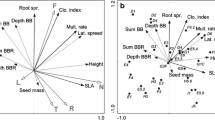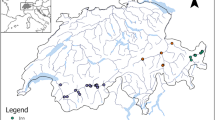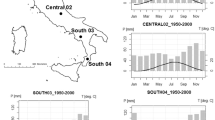Abstract
In a secondary successional community, we focused on the role of local dispersion mediated by clonal growth in the density and spatial patterning of tillers of three dominant grass species (Elymus repens, Brachypodium pinnatum and Calamagrostis epigejos) on the plant neighbourhood scale. We also asked whether the spatial pattern/density of their tillers were linked to the local diversity structure. In ten 75 cm × 75 cm quadrats for each of the three species, we quantified i) the clonal morphology patterns from measuring spacer length, branching rate and the number of clumping tillers per module, ii) the spatial patterns and density of tillers in grids at four different resolutions (cell sizes varied between 1 cm × 1 cm; 2.5 cm × 2.5 cm; 5 cm × 5 cm and 7.5 cm × 7.5 cm), and iii) local species richness and local dominance based on botanical relevés. Then, we explored the relationships between iv) the clonal architecture pattern and the density/spatial pattern of tillers and v) the density/spatial pattern of tillers and local diversity variables, through regression analyses. Aggregation intensity on the smallest scales and tiller density were negatively linked to spacer length and positively linked to branching rate and number of clumping tillers. Species richness and dominance in quadrats were negatively and positively linked to tiller density, respectively. Dominance was positively linked to aggregation intensity on a 1-cm scale. This study emphasized and quantified the importance of clonal growth in the intensity and quality of grass tiller patterning in space on the plant neighbourhood scale. Our approach allowed the accurate positioning of species, or even clones on the phalanx-guerrilla continuum. This should help us to understand how dominant grass species affect the dynamics of stand communities.





Similar content being viewed by others
References
Alberto F, Gouveia L, Arnaud-Haond S, Pérez-Lloréns J, Duarte CM, Serrão EA (2005) Within-population spatial genetic structure, neighbourhood size and clonal subrange in the seagrass Cymodocea nodosa. Molec Ecol 14:2669–2681
Aubry P (2000) Le traitement des variables régionalisées en ecologie, apports de la géomatique et de la géostatistique (Regionalised variables processing in ecology: contribution of geomatics and geostatistics). Université Claude-Bernard, Lyon
Bell AD (1984) Dynamic morphology: a contribution to plant ecology. In Dirzo R, Sarukhán J (eds) Perspectives in plant population ecology. Sinauer, Sunderland, pp 48–65
Berger U, Piou C, Schiffers K, Grimm V (2008) Competition among plants: Concepts, individual-based modelling approaches, and a proposal for a future research strategy. Perspect Pl Ecol Evol Syst 9:121–135
Bolker BM, Pacala SW (1999) Spatial moment equations for plant competition: Understanding spatial strategies and the advantages of short dispersal. Amer Naturalist 153:575–602
Dieckmann U, Law R, Metz JAJ (2001) The geometry of ecological interaction. Simplifying spatial complexity. Cambridge University Press, Cambridge
Doak DF, Loso MG (2003) Effects of grizzly bear digging on alpine plant community structure. Arctic Antarct Alpine Res 35:421–428
Fahrig L, Coffin DP, Lauenroth WK, Shugart HH (1994) The advantage of long-distance clonal spreading in highly disturbed habitats. Evol Ecol 8:172–187
Fischer M, Van Kleunen M, Schmid B (2004) Experimental life-history evolution: Selection on growth form and its plasticity in a clonal plant. J Evol Biol 17:331–341
Fortin MJ, Dale MRT, Ver Hoef J (2002) Spatial analysis in ecology. In El-Shaarawi AH, Piegorsch WW (eds) Encyclopedia of environmetrics 4. John Wiley & Sons, Ltd, Chichester, pp 2051–2058
Fridley JD, Grime JP, Bilton M (2007) Genetic identity of interspecific neighbours mediates plant responses to competition and environmental variation in a species-rich grassland. J Ecol 95:908–915
Gough L, Goldberg DE, Hershock C, Pauliukonis N, Petru M (2001) Investigating the community consequences of competition among clonal plants. Evol Ecol 15:547–563
Halassy M, Campetella G, Canullo R, Mucina L (2005) Patterns of functional clonal traits and clonal growth modes in contrasting grasslands in the central Apennines, Italy. J Veg Sci 16:29–36
Herben T (1992) Coexistence and pattern diversity in communities of clonal organisms: a model based on cellular automata. Abstr Bot 16:49–54
Herben T (2004) Physiological integration affects growth form and competitive ability in clonal plants. Evol Ecol 18:493–520
Herben T, Hara T (2003) Spatial pattern formation in plant communities. In Sekimura T, Noji S, Ueno N, Maini PK (eds) Morphogenesis and pattern formation in biological systems – experiments and models. Springer-Verlag, Tokyo, pp 223–235
Herben T, Suzuki J-I (2001) A simulation study of the effects of architectural constraints and resource translocation on population structure and competition in clonal plants. Evol Ecol 15:403–423
Humphrey LD, Pyke DA (1998) Demographic and growth responses of a guerrilla and a phalanx perennial grass in competitive mixtures. J Ecol 86:854–865
Hutchings MJ, de Kroon H (1994) Foraging in plants: the role of morphological plasticity in resource acquisition. Advances Ecol Res 25:159–238
Klimeš L, Klimešová J (1999) A database of clonal plants in central Europe. Pl Ecol 141:9–19
Klimeš L, Klimešová J, Hendricks R, van Gronendael J (1997) Clonal plant architecture: a comparative analyses of form and function. In Kroon H, Van Gronendael J (eds) The ecology and evolution of clonal plants. Backhuys Publishers, Leiden, pp 1–29
Klimešová J, Klimeš L (2007) Bud banks and their role in vegetative regeneration – A literature review and proposal for simple classification and assessment. Perspect Pl Ecol Evol Syst 8:115–129
Klotz S, Kühn I, Durka WH (2002) BIOLFLOR – Eine Datenbank zu biologisch-ökologischen Merkmalen der Gefäßpflanzen in Deutschland. Schriftenreihe für Vegetationskunde, Bundesamt für Naturschutz, Bonn
Lafarge M (2001) Three approaches for analysing the dynamics of the horizontal layout of tillers in grass patches. Application to tall fescue swards surveyed over two growing seasons. Acta Oecol 22:109–119
Law R, Dieckmann U (2000) A dynamical system for neighborhoods in plant communities. Ecology 81:2137–2148
Levin SA (1992) The problem of pattern and scale in ecology. Ecology 73:1943–1967
Lovett Doust L (1981) Intraclonal variation and competition in Ranunculus repens. New Phytol 89:495–502
Mercer KL, Jordan NR, Wyse DL, Shaw RG (2002) Multivariate differentiation of quackgrass (Elytrigia repens) from three farming systems. Weed Sci 50:677–685
Murrell DJ, Purves DW, Law R (2001) Uniting pattern and process in plant ecology. Trends Ecol Evol 16:529–530
Navas M-L, Garnier E (1990) Demography and growth forms of the clonal perennial Rubia peregrina in Mediterranean vineyard and unmanaged habitats. J Ecol 78:691–712
Oborny B, Bartha S (1995) Clonality in plant communities – an overview. Abstr Bot 19:115–127
Oinonen E (1967) Sporal regeneration of bracken (Pteridium aquilinum (L.) Kuhn.) in Finland in the light of the dimensions and the age of its clones. Acta Forest Fenn 83:1–96
Pacala SW, Levin SA (1997) Biologically generated spatial pattern and the coexistence of competing species. In Tilman D, Kareiva P (eds) Spatial ecology: The role of space in population dynamics and interspecific interactions. Princeton University Press, Princeton, pp 204–232
Pottier J, Marrs RH, Bédécarrats A (2007) Integrating ecological features of species in spatial pattern analysis of a plant community. J Veg Sci 18:223–230
Purves DW, Law R (2002) Fine-scale spatial structure in a grassland community: quantifying the plant’s-eye view. J Ecol 90:121–129
Rees M, Grubb PJ, Kelly D (1996) Quantifying the impact of competition and spatial heterogeneity on the structure and dynamics of a four-species guild of winter annuals. Amer Naturalist 147:1–32
Rejmánek M., Chesson P, Neuhauser C, Murrell D, Purves D, Law R (2002) Intraspecific aggregation and species coexistence (multiple letters). Trends Ecol Evol 17:209–211
Sackville Hamilton NR, Schmid B, Harper JL (1987) Life history concepts and the population biology of clonal organisms. Proc Roy Soc London 232:35–57
Sammul M, Kull K, Tamm A (2003) Clonal growth in a species-rich grassland: Results of a 20-year fertilization experiment. Folia Geobot 38:1–20
Scheepens JF, Veeneklaas RM, Van De Zande L, Bakker JP (2007) Clonal structure of Elytrigia atherica along different successional stages of a salt marsh. Molec Ecol 16:1115–1124
Schläpfer F, Fischer M (1998) An isozyme study of clone diversity and relative importance of sexual and vegetative recruitment in the grass Brachypodium pinnatum. Ecography 21:351–360
Schmid B, Harper JL (1985) Clonal growth in grassland perennials: I. Density and pattern-dependent competition between plants with different growth forms. J Ecol 73:793–808
Simpson EH (1949) Measurement of diversity. Nature 163:688
Skálová H, Pecháčková S, Suzuki J, Herben T, Hara T, Hadincová V, Krahulec F (1997) Within population genetic differentiation in traits affecting clonal growth: Festuca rubra in a mountain grassland. J Evol Biol 10:383–406
Song M, Dong M, Jiang G (2002) Importance of clonal plants and plant species diversity in the Northeast China transect. Ecol Res 17:705–716
Stoll P, Prati D (2001) Intraspecific aggregation alters competitive interactions in experimental plant communities. Ecology 82:319–327
Tilman D (1994) Competition and biodiversity in spatially structured habitats. Ecology 75:2–16
Tilman D, Kareiva P (1997) Spatial ecology: The role of space in population dynamics and interspecific interactions. Princeton University Press, Princeton
Van Groenendael JM, Klimeš L, Klimešová J, Hendriks RJJ (1996) Comparative ecology of clonal plants. Philos Trans, Ser B 351:1331–1339
Venables WN, Ripley BD (2002) Modern applied statistics with S. Springer, New York
Whitham TG, Young WP, Martinsen GD, Gehring CA, Schweitzer JA, Shuster SM, Wimp GM, Fischer DG, Bailey JK, Lindroth RL, Woolbright S, Kuske CR (2003) Community and ecosystem genetics: A consequence of the extended phenotype. Ecology 84:559–573
Winkler E, Fisher M (2002) The role of vegetative spread and seed dispersal for optimal life histories of clonal plants: a simulation study. Evol Ecol 15:281–301
Wildová R (2004) Below-ground spatial pattern of rhizomes in a grassland community and its relevance to above-ground spatial pattern. Pl Ecol 174:319–336
Wildová R., Wild J, Herben T (2007) Fine-scale dynamics of rhizomes in a grassland community. Ecography 30:264–276
Ye XH,Yu FH, Dong M (2006) A trade-off between guerrilla and phalanx growth forms in Leymus secalinus under different nutrient supplies. Ann Bot 98:187–191
Acknowledgements
We are grateful to Sébastien De Danieli and Rémi Hanon for help in the field. We also would like to thank the associated editor and the referees for their valuable comments on the first versions of the manuscript.
Author information
Authors and Affiliations
Corresponding author
Rights and permissions
About this article
Cite this article
Pottier, J., Evette, A. On the Relationship Between Clonal Traits and Small-Scale Spatial Patterns of Three Dominant Grasses and its Consequences on Community Diversity. Folia Geobot 45, 59–75 (2010). https://doi.org/10.1007/s12224-009-9053-x
Received:
Revised:
Accepted:
Published:
Issue Date:
DOI: https://doi.org/10.1007/s12224-009-9053-x




